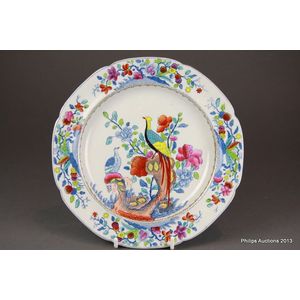Chinese Imari Pitt Armorial Charger
You must be a subscriber, and be logged in to view price and dealer details.
Subscribe Now to view actual auction price for this item
When you subscribe, you have the option of setting the currency in which to display prices to $Au, $US, $NZ or Stg.
- Armorial / Armourial - Bearing a coat of arms. Coats of arms came into general use by feudal lords and knights in in the 12th century, and by the 13th century, arms had spread beyond their initial battlefield use to become a flag or emblem for families in the higher social classes of Europe. They were inherited from one generation to the next. When a family crest is used on individual items of silver or furniture it is an indicator of the aristocratic standing of the family represented.
Armorials were also used to decorate mass produced ceramic souvenir ware by such companies as Goss, Carlton & Shelley, and in these cases the coats of arms displayed were of boroughs and cities. - Charger - A charger is a type of large plate, typically used as a decorative base for smaller plates or bowls. They are often used in formal settings, such as at a banquet or a special occasion.
The history of chargers can be traced back to medieval times, when they were used as a base for serving dishes in banquet settings. They were typically made of metal, such as silver or pewter, and were highly decorative, often featuring intricate engravings or designs.
During the Renaissance period, chargers began to be made of porcelain, and their designs became more ornate. They were often used in the homes of the wealthy and were considered a symbol of wealth and status.
In the 18th and 19th centuries, chargers were produced in great numbers by European porcelain manufacturers, and they were exported to America and other parts of the world. They were highly sought after by the upper class and were often used as a decorative element in formal table settings.
This item has been included into following indexes:
Visually similar items

Top quality antique Chinese porcelain dish decorated in bright famille rose enamels with gambolling horses. No marks. Early 18th century, Yongzheng reign (1723-1735). Tiny frit to rim, and some expected signs of wear and use. Diameter 22.7 cm

A Chinese famille rose plate, Qing dynasty, circa 18th century, decorated with a deer, flower basket, and scrolls to the interior, 22.4 cm diameter

A Spode 'Pheasant' pattern dessert plate, circa 1820, decoration pattern 2240, circular with indented edge, decorated in coloured enamels over the transfer-printed design in blue, printed 'Stone-china' mark underside. Diameter 20.5 cm

A Chinese export porcelain plate, painted in polychrome famille rose enamels with a scene of cockerels in a garden. Diameter 23 cm
